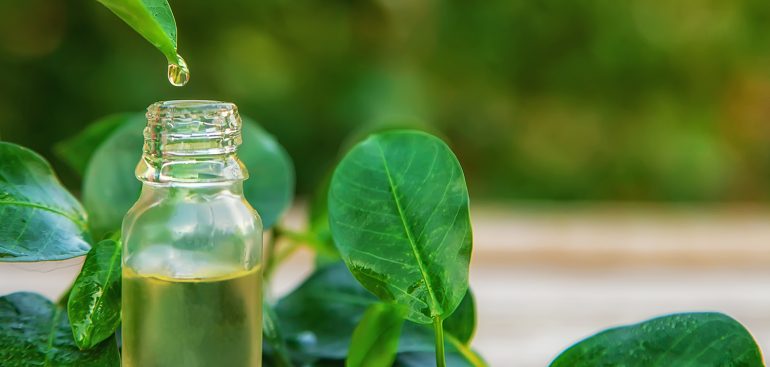Tea tree essential oil (TTO) is one of the most widely used worldwide. It can be easily found in the form of pure essential oil in pharmacies, supermarkets, and specialty stores, and is used as an ingredient in many cosmetic products, due to its antibacterial and anti-inflammatory properties.
TTO is obtained by steam distillation of the leaves and terminal branches of the Australian native plant Melaleuca alternifolia. The yield of oil is 1-2% of the wet plant material weight. It contains circa 100 constituents and there are six chemotypes, but only one is used commercially, the terpinene-4-ol, which contains 30-40% of this constituent. Within the terpinene-4-ol chemotype, there is a great chemical variability, but it has not been shown to impact the biological effects of the oil, neither in vitro nor in vivo.
Aboriginal Australians traditionally used the leaves of the tea tree to treat skin and respiratory diseases. In the 18th century, sailors arriving in Australia dubbed the plant a “tea tree”, because they used the leaves to make an infusion that smelled of nutmeg. It was not until the early twentieth century that it was discovered that essential oil had an antimicrobial capacity 11 times higher than phenol, the golden standard of the time, and its use became popular.
Currently, multiple scientific studies document the effectiveness of TTO in the treatment of wounds, insect bites, lice, fungal infections affecting bones, nails and skin, dandruff, seborrheic dermatitis, chronic gingivitis and acne vulgaris.
TTO is considered safe, but it can cause contact dermatitis in some patients. Concentrations up to 10% have been tested with few side effects, but the continued use of such high concentrations is discouraged, and the direct application of the pure essential oil must be avoided. A concentration of 5% is recommended for shock treatments and below 2% for long-term treatments.
Like all essential oils, TTO is not soluble in water, which can make it difficult to formulate water-based products. In addition, it is volatile, and there are plastic materials that absorb it, so it is recommended to choose products that are well formulated and to be extremely careful with DIY recipes.
Mechanisms of action
TTO has a broad-spectrum antimicrobial activity, being effective against Gram-positive and Gram-negative bacteria, protozoa, fungi and virus. The mechanism of antibacterial action is through nonspecific damage to the bacterial cell membrane, which results in loss of intracellular material, inability to maintain homeostasis and inhibition of respiration. The main antibacterial activity is carried out by terpinen-4-ol and α-terpineol, but the other constituents of the oil also contribute to its effect.
TTO shows anti-inflammatory action, impacting a range of immune responses, and decreasing the production of free radicals.
Use of tea tree oil to treat acne
Acne vulgaris is a chronic skin disease that occurs when hair follicles are blocked with dead skin cells, bacteria, and oil (sebum). The blocked follicles cause lesions on the skin, including pimples, blackheads, whiteheads, papules, nodules, and cysts. The cause of the disease is multifactorial, including excessive sebum production, low desquamation rate of the follicular epithelium, inflammation, and the presence of the acne-causing bacteria Cutibacterium acnes.
Conventional antiacne treatments include the following mechanisms of action:
- Antibacterial activity, especially against Cutibacterium acnes (antibiotics, benzoyl peroxide)
- Antiinflammatory (retinoids)
- Normalization of the keratinization of the follicles (retinoids)
- Reduction of sebum production (retinoids)
- Keratolytic activity (beta hydroxy acids, in example salicylic acid)
TTO is present in many over the counter anti-acne products, and it is often chosen by patients who decide to self-treat. As explained above, TTO only works through mechanisms of action 1 and 2 (antibacterial and anti-inflammatory). However, several studies have shown that TTO reduces the number of lesions in patients with mild to moderate acne:
- A study showed that TTO was better than placebo
- Another study showed that TTO was equivalent to 5% benzoyl peroxide and 2% topical erythromycin
- Another study showed that a face wash and a facial gel reduced lesion counts and were safe to use.
- A study demonstrated that 5% TTO had similar effectiveness as 5% benzoyl peroxide, with less side effects, although the TTO treatment was slower.
- An investigation showed the effectiveness of topical TTO alone and in combination with an oral Ayurvedic treatment.
- Two studies demonstrated the effectiveness of TTO combined with other natural ingredients.
All these research studies show that TTO is an effective and safe alternative for the treatment of moderate acne, and that it satisfies the patient’s willingness to use natural products to solve common health problems.



